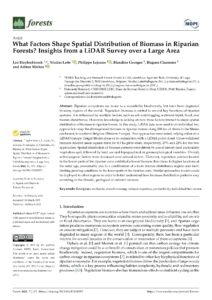
Huylenbroeck L., Latte N., Lejeune P., Georges B., Claessens H., Michez A. [2021] What Factors Shape Spatial Distribution of Biomass in Riparian Forests? Insights from a LiDAR Survey over a Large Area. Forests 12, 371
Abstract : Riparian ecosystems are home to a remarkable biodiversity, but have been degraded in many regions of the world. Vegetation biomass is central to several key functions of riparian systems. It is influenced by multiple factors, such as soil waterlogging, sediment input, flood, and human disturbance. However, knowledge is lacking on how these factors interact to shape spatial distribution of biomass in riparian forests. In this study, LiDAR data were used in an individual tree approach to map the aboveground biomass in riparian forests along 200 km of rivers in the Meuse catchment, in southern Belgium (Western Europe). Two approaches were tested, relying either on a LiDAR Canopy Height Model alone or in conjunction with a LiDAR point cloud. Cross-validated biomass relative mean square errors for 0.3 ha plots were, respectively, 27% and 22% for the two approaches. Spatial distribution of biomass patterns were driven by parcel history (and particularly vegetation age), followed by land use and topographical or geomorphological variables. Overall, anthropogenic factors were dominant over natural factors. However, vegetation patches located in the lower parts of the riparian zone exhibited a lower biomass than those in higher locations at the same age, presumably due to a combination of a more intense disturbance regime and more limiting growing conditions in the lower parts of the riparian zone. Similar approaches to ours could be deployed in other regions in order to better understand how biomass distribution patterns vary according to the climatic, geological or cultural contexts.
Consultez la notice complète de l’article sur ORBi
